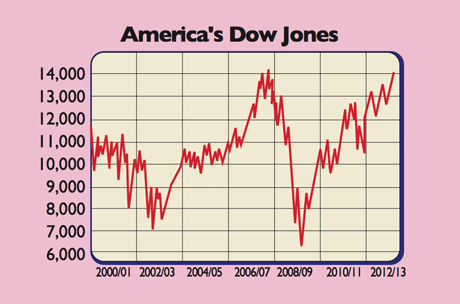The world's oldest market index has hit a new record. America's 117-year-old Dow Jones index has eclipsed the 14,164 level it reached in October 2007. The equity rally has also propelled the S&P 500 index to near-record highs. European stocks are at four-and-a-half-year peaks.
What the commentators said
Investors should always take the Dow index's readings with a huge pinch of salt, said John Authers on FT.com. It's hardly representative of the US market: it contains just 30 stocks, as opposed to the S&P's 500.
It is also skewed because its constituents are weighted by share price rather than their market capitalisation. So firms that happen to have a higher share price in dollars can outweigh their bigger counterparts with lower-priced stock.
MoneyWeek
Subscribe to MoneyWeek today and get your first six magazine issues absolutely FREE

Sign up to Money Morning
Don't miss the latest investment and personal finances news, market analysis, plus money-saving tips with our free twice-daily newsletter
Don't miss the latest investment and personal finances news, market analysis, plus money-saving tips with our free twice-daily newsletter
These quibbles aside, however, the index's new record, along with the buoyancy seen in other indices, makes it clear the bulls are out in force. They're also "sleepwalking", said Nicholas Colas of ConvergEx Group, a finance technology company. Investors are ignoring potential future turbulence in the eurozone and US politics, and earnings aren't growing fast enough to justify the recent rapid market rises.
Indeed, S&P 500 companies' earnings are expected to decline by 1.7% year-on-year this quarter, said Leslie Picker on Bloomberg.com. Meanwhile, the developed world is still showing "precious few signs of sustained recovery", said Chris Giles in the Financial Times.

These lacklustre fundamentals are secondary. The key for investors is that central banks, led by the US Federal Reserve, are printing money in order to secure the recovery, and will do even more of this if the global recovery shows signs of faltering again. Not only does all this liquidity spur recovery hopes, but a lot has "leaked into stocks", said ES Browning in The Wall Street Journal.
The fact that we have yet to see a sustainable global recovery, despite all this money printing, doesn't seem to be worrying investors. The Dow's new high tells us that "misplaced faith in the Federal Reserve's ability to fix the economy [has] recovered to pre-crisis levels", said The Wall Street Journal.
Stockmarkets can be driven by faith and liquidity, as opposed to fundamentals, for a surprisingly long time, but of course the higher they go, the more vulnerable they are to a nasty slide. "Historically, just when the Dow looks to have hit its most enthusiastic highs," said Heidi Moore on Guardian.co.uk, "a crash is around the corner." Dow at a record? "Smile briefly. Then duck."
Get the latest financial news, insights and expert analysis from our award-winning MoneyWeek team, to help you understand what really matters when it comes to your finances.
MoneyWeek is written by a team of experienced and award-winning journalists, plus expert columnists. As well as daily digital news and features, MoneyWeek also publishes a weekly magazine, covering investing and personal finance. From share tips, pensions, gold to practical investment tips - we provide a round-up to help you make money and keep it.
-
 The political economy of Clarkson’s Farm
The political economy of Clarkson’s FarmOpinion Clarkson’s Farm is an amusing TV show that proves to be an insightful portrayal of political and economic life, says Stuart Watkins
-
 Profit from leisure sector as consumers go on spending spree
Profit from leisure sector as consumers go on spending spreeThe UK leisure sector had a straitened few years but now have cash in the bank and are ready to splurge. The sector is best placed to profit

